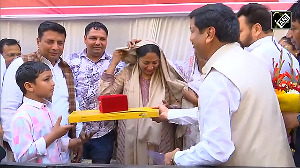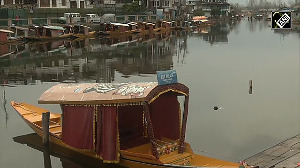Parliamentarians will go home feeling secure that they have created a National Investigation Agency. All the debate on security aspects was confined to the recent despicable happenings in Mumbai. But the circumference of security challenges to our nation is much wider.
The Chinese attack in 1962 had alerted India to the lurking challenge in the Northeast. Alas, the 46-year record of the government's response to that challenge, especially in Arunachal Pradesh, is pitiable if not unpardonable.
Though stoutly rebutted by External Affairs Minister Pranab Mukherjee, the November 2008 renewed statement of Beijing about the status of Arunachal has generated disquiet among the people of the state who see the Chinese troops day to day massed right next to their skin. The brunt of the 1962 Chinese foray was borne largely by the people of Arunachal. They are in the firing line though the challenge is nationwide.
Authorities are aware of it and in the past few days have set afoot various development initiatives. Reports Hindustan Times, November 21, 'Bharat Nirman, thanks to China - nervous at our giant neighbour's slow creep towards the border the government has initiated development projects.'
The army stationed in Arunachal is also reported to favour development initiatives and is ready to assist Bharat Nirman, a time-bound plan for creating rural infrastructure like water supply and health and education facilities.
An institutional underpinning erected for development, which rests on the shoulders of the people in the state, is fundamental to obtaining successful and speedy results from development endeavours. Post-1962 at least, the various bhawans in New Delhi were required to act in concert and mobilise the people of Arunachal and help them to gather their strength and energy.
But that hope has been belied as evident from the independent assessment of the state of panchayatraj (2007-08) in 30 states and Union territories including Arunachal, sponsored by the ministry of panchayat raj and conducted by IRMA [Institute of Rural Management, Anand] under the guidance of its chairman Prof Yogendra Alagh, one of our distinguished economists and a former member of the planning commission.
Before we come to this assessment a word about Arunachal. Its population is a little over one million. In geographical area this is the largest state in the Northeastern region. Its area is larger than that of Assam which has a population of nearly 27 million. Scheduled tribes comprise two-thirds of the population of Arunachal. There are 20 major tribes and a number of sub-tribes.
Believe it or not, 10 years after the Chinese attack in 1962, the political pandits and bureaucrats in Delhi held Arunachal's population to be a trifle too small to be entitled to self-government. They designated Arunachal as a Union territory in 1972 to be administered by the home ministry through bureaucrats.
This move undermined the people's role in national defence in that fire spot. Imagine, the people of Arunachal were given no say as responsible citizens in the development and defence of their area.
Twenty years later, in 1992, the 73rd Constitution amendment aimed to create 'institutions of self-government' in every village, hamlet and town, in the country. It took another 10 years after the amendment for the Arunachal panchayats enactment to emerge in 2001. The first panchayat election was conducted in April 2003, ie, 40 years after the 1962 episode.
The number of representatives elected across Arunachal is 7,415 of whom 90 per cent are tribals. They could be a formidable force in any endeavour of national development and defence. But to the detriment of national interest they have not yet been vested with even a fraction of the powers or resources as mandated by the Constitution, which entailed substantial devolution of functions, functionaries and finances.
As per the 2007-08 independent assessment report; Functions: in terms of policy, planning, implementation, coordination/control devolved to various tiers of panchayat raj, there is little clarity and the elementary principle of subsidiary, ie, (what can be done by the lower level should not be assigned to a higher level) has not been adhered to; Functionaries: have not been transferred to panchayat raj bodies. They continue to be under the direct control of state departments. Finances (funds): till now funds have not been transferred to the panchayats. Also there is no separate window of panchayats in the state budget or budgets of line departments. Even the resources raised by anchal samitis can be spent by them only with the prior approval of the concerned deputy commissioner!
Practically, gram sabha is not being held in all the panchayats as per the Act. The state institute of rural development in Itanagar was started in 1993 but funds for training of panchayat members were released only in 2006-07, ie, 13 years later.
There is a plan to establish e-governance at the directorate of panchayat raj and zilla parishads. All the zilla parishads are provided with telephone and mobile connections. Around 60 per cent of anchal samitis also have telephone connectivity. But, at the base, the gram panchayats do not have telephone connectivity.
Despite elected panchayats with 7,415 representatives, apparently on the insistence of the rural development ministry, the district rural development agency, an administrative creature continues to exist as a separate body and not merged with panchayats. The most vital schemes such as Swarnajayanti Gram Swarojgar Yojana, Sampurna Grameen Rojgar Yojana, National Rural Employment Guarantee Scheme and Total Sanitation Programme Indira Awas Yojana are all implemented by district rural development agency. The Sarva Siksha Abhiyan is implemented by the education department.
The 7,415 elected representatives are thus wantonly rendered an idle force. Imagine if the soldiers stationed at the border were also likewise ill-equipped and disrobed of any authority. In the event, it is clear that the Bharat Nirman programme now invoked will be retained almost entirely in bureaucratic hands and funds will be spent by them without involving the people.
Is this New Delhi's notion of 'Bharat Nirman'? Can its goals be attained without its being led and directed by the people?
The IRMA Assessment concludes: 'One cannot escape noticing a sense of low morale among elected members of panchayats due to the functional vacuum they face.' We must not weaken the capacity of our people to defend their land and livelihood.






 © 2025
© 2025